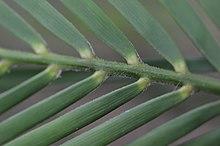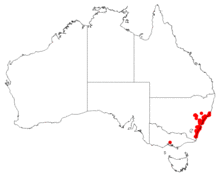| Macrozamia communis | |
|---|---|
 | |
| Macrozamia communis | |
 | |
| Showing lack of veins in the pinnae, and yellowish colour at the attachment | |
| Scientific classification | |
| Kingdom: | Plantae |
| Clade: | Tracheophytes |
| Division: | Cycadophyta |
| Class: | Cycadopsida |
| Order: | Cycadales |
| Family: | Zamiaceae |
| Genus: | Macrozamia |
| Species: | M. communis |
| Binomial name | |
| Macrozamia communis L.A.S.Johnson, 1959 | |
 | |
| Occurrence data from AVH | |
Macrozamia communis is an Australian cycad found on the east coast of New South Wales. The common name for the species is burrawang, a word derived from the Daruk Australian Aboriginal language; this name is also often applied to other species of Macrozamia.
The burrawang has the most extensive distribution of any cycad in New South Wales and is found along the coast from the district around Armidale, New South Wales to Bega 700 km south and on the coastal slopes of the Great Dividing Range with some instances on the inland slopes of the range; as far west as the Mudgee district. It is most abundant on the south coast of the state.[2]
The plants grow in open forests.[3]

Seed cones are formed after fire. Male and female seed cones are on separate plants and the large female seeds are ripe when red or yellow.[3]
Individual specimens take 10–20 years to mature and may live for up to 120 years.[4]
Seedlings of Macrozamia communis have a tuber and coralloid roots that rise up above the ground containing cyanobacteria. These exist in a symbiotic relationship with the cycad by nitrogen fixation.[4]
The seeds of the burrawang are a good source of starch but are poisonous to eat unless treated. The Cadigal people pounded and soaked the seeds in water for a week, changing the water daily. The pulp was then made into cakes and roasted over hot embers.[5]
The conservation status of the species is "not considered to be at risk".[6]
References
- ^ Hill (2003). "Macrozamia communis". IUCN Red List of Threatened Species. 2003. Retrieved 12 May 2006.
- ^ Kennedy, P. (1993). "Macrozamia communis". Cycads. Palm and Cycad Societies of Australia (PACSOA). Retrieved 30 April 2006.
- ^ a b "Burrawang". Australian Aboriginal ethnobotany. Australian National Botanic Gardens. 2003. Retrieved 30 April 2006.
- ^ a b Benson, Doug; McDougall, Lyn (1993). "Ecology of Sydney Plant Species Part 1: Ferns, fern-allies, cycads, conifers and dicotyledon families Acanthaceae to Asclepiadaceae" (PDF). Cunninghamia. 3 (2): 257–422 [336]. Archived from the original (PDF) on 11 March 2011.
- ^ "Aboriginal bush foods". Botanical information - Botanic Gardens Trust - Sydney, Australia. Department of Environment and Conservation (NSW). Archived from the original on 2 May 2006. Retrieved 30 April 2006.
- ^ Hill, K. (2004). "Macrozamia communis". The Cycad Pages. Royal Botanic Gardens Sydney. Archived from the original on 18 June 2006. Retrieved 30 April 2006.
